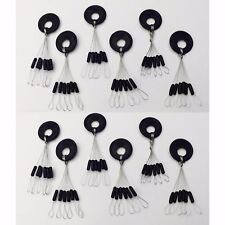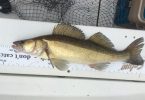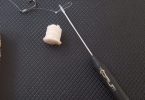Intro
As autumn turns to winter and the first proper chill can be felt in the air, my thoughts always turn to my favourite fishing of all – small-river chubbing. There’s no other form of fishing that excites me as much as quietly exploring an intimate river, wrapped up against the cold, a flask of hot tea, baiting up swims and quivertipping big baits, hoping the tip will tremble and pull round and I’ll feel the thump of a big chub – magic!
Fishing for chub in this way is extremely selective. If you get a bite and hook a fish using the following baits and tactics, it will almost certainly be a chub. Hopefully a big chub!

A cracking winter chub caught on a big blob of cheese paste
Bait
If chub are famous for one thing, it’s their unfussy dietary requirements. Any bait well presented will catch big chub, from small baits like maggots and casters, traditional baits like bread and cheesepaste, predatory baits like lamprey section or small livebaits, to the spillover baits from carp and barbel fishing like boilies and pellets.
Nearly all my chubbing is done with either bread or cheesepaste. The maggot approach can take time to build up a swim by constant feeding, and is better tackled with trotting gear; on the rivers I fish, fish baits will just bring in hundreds of crayfish; and carp-style baits are just not necessary, and usually require some kind of hair rig, which is not best suited to the chub. But mainly, roving about and quivertipping big, traditional baits is what I enjoy most, and that’s what it’s all about.
The key to this style of chubbing is to be very mobile, fish lots of likely looking spots, and drop a large bait – which provides lots of energy for very little effort – into each one and hope for a quick bite. Big means big, too – a friend of mine uses what he calls ‘a pinch of flake’ which is virtually a whole slice of white bread!
Rigs and Tackle
Nice and simple – an avon-style rod of about 1.25lb test curve with the most sensitive quivertip you can get away with (with isotopes attached ideally, for fishing on after dark), a small reliable fixed spool reel, and 6lb mainline. The rest of your tackle should be as stripped down as possible, as there will be an awful lot of moving swims and walking involved – a lightweight chair, a bag containing a small tackle box, bait, and other essentials (like a flask of tea!), a couple of rod rests, a landing net, and if rain is likely, a brolly.
The rig I tend to use most is a simple free running leger. This is designed to be as resistance free and as easily modified as possible, allowing clear indication and the ability to add/remove swan shots, legers, or feeders.
Chub rig
The mainline is 6lb mono. Running on that is a wide-bore run ring, with 6” of stiff 15lb mono tied to it, and on the other end a link swivel. On the end of the mainline tie a small swivel, and onto the other eye of the swivel a 12” hook length of 6lb double strength (or similar). Onto that goes a size 6 barbless hook (chub often wolf down big baits and a barbless hook is easier to remove).
For weight, you can either attach a lead or feeder to the link swivel, or pinch swan shot onto the link above the link swivel. This simple rig is very versatile, won’t tangle, and as it is so free running, doesn’t make the chub nervous, and encourages nice positive bites.
There are lots of variations on this basic link leger rig. This one works for me on my local rivers, but to be honest as long as your rig shows bites well and doesn’t tangle, it’s not that important.
Location, baiting and tactics
The first thing to say is that small-river chub – especially the big ones – are spooky, and will not tolerate disturbance. If you tread noisily, stand over the water, make a racket with chairs and banksticks, trample down bankside vegetation, or do anything else that will put the fish on edge, you may as well move onto the next swim. Rule number one is, be silent.
Location
Now we get to the main point – this is where success or failure is determined! Choice of bait and tackle is not massively important really, and everyone has their own favourites, but choosing the right spots, baiting them properly and fishing them quietly and effectively is the real trick.
Small rivers (usually tributaries of major rivers) can be roughly divided into two types – fast and slow. The faster rivers often contain fish like trout, dace, barbel and roach as well as chub, and are fairly pacy, often clear, and run over gravel with alternate riffles, glides and pools. The slower rivers usually contain bream, sometimes barbel, roach and pike and are more uniform in depth and character.
In general, location on the faster rivers is easier, as the chub will be in classic Mr Crabtree areas where the current is slow or slack – undercut banks, deeper pools, behind obstructions, and ideally with cover overhead too.
On the slower rivers, location is aided by extra water, which pushes the chub into the slower or slack areas, like on the fast rivers. In normal conditions they could be almost anywhere if the current is not too fast, but snags, deeper spots, cover and the slower side of the main current are all reliable areas to explore. In low or clear water, if you’re a bit worried about casting in case you get snagged, you’re probably in the right spot! In snag swims, the closer you can get a bait, the better, and if you come home without losing any hook lengths to trailing branches or submerged tree roots, you’ve either been very lucky or not brave enough!
What to look for:

Any spot like this – relatively deep water and cover – is likely to hold chub.

This is a nice spot. There is a crease between the main current and the back eddy, and the bank in undercut too, providing cover. It just screams chub!

This is a classic crease swim on the outside of a bend. The chub will be in the slack water near the far bank, taking advantage of food brought along the main current.

Any form of cover like this on an otherwise featureless stretch of river will probably hold chub, and in winter the leaves will be replaced by a weed raft as detritus accumulates in the trailing branches.

One of those ‘boring’ featureless stretches with a slow, comfortable current and plenty of near-bank snags. A very pleasant place for a chub to live!
So, there are two key clues to locating our small-river chub – flow and snags/cover.
The most important of these is usually flow. Chub like to be in a comfortable flow just off the main current, in a reasonable depth of water. The higher the river and faster the flow, the slacker the water we need to look for. Cover is almost as important, but if the flow is too fast or if the water underneath is too shallow, a cracking looking overhanging tree is fools gold. However, if that tree overhangs a spot where the water is reasonably deep and the flow is slower than the main current, you’ve just found a banker.
Snags like tree roots, reedbeds and other obstructions are also very attractive to chub – as long as the flow is right.
The biggest clue to look for is what the surface water is doing. If it is broken or swirly, it is likely to be too fast or uncomfortable for chub. If it is smooth and slow or slack – even better if it is next to fast water, the classic crease swims – chub will tolerate it.
When it comes to locating these small-river chub, you need to look at the river each time with fresh eyes. Flows change, colour changes, rafts move – it’s a different river each time. A good spot last session could well be useless a week later. The fish move to the most suitable places for the conditions on the day, and are very transient. We need to find them afresh each time, which is part of the attraction of trying to catch them! These fish holding spots can be anything from a deep, slow (and boring-looking) stretch, to a very small slack behind some tree roots right under your feet.
Baiting up
Small river chubbing is, thankfully, not that popular, especially as it’s mainly a winter pursuit, so you can often expect to have the river to yourself. The idea is to weigh up the conditions on the day, bait up several chubby looking spots, and quietly fish them in turn, hoping to catch one, maybe two, fish from each spot. One fish is normally it – it’s a hit and run style of fishing, and any other chub in the swim will normally spook when the first one is hooked.
Most of your time is spent without a bait in the water. The first job is to drop your tackle off somewhere safe and walk the entire stretch with just bait and, depending on the conditions, a rod with a bait dropper attached, looking for the little spots where a chub or two might be hiding, and to introduce a few hookbait samples. Each swim is then left for at least 20-30 minutes to settle. The idea is to get any fish present feeding confidently so that when you drop your hookbait in later, they nail it straight away, give you a lovely confident bite, and you catch a fish quickly. As it is often the biggest fish that will grab a bait after a half an hour wait, you have a good chance of plucking out the specimen from the swim.
As you wander the river looking for these chubby spots, quietly bait up each one with half a dozen samples of whatever you are using as bait or a couple of balls of bread mash. If your bait doesn’t sink very easily or you need to deposit bait in fastish water, which will take the samples downstream into a chubby spot, use the baitdropper to get it down to the bottom. When throwing in samples by hand, take note of the flow and throw them far enough upstream so that they come to rest on the bottom where you want them to.
Now you need to rest the swims and allow the chub to find the free offerings, eat them, and be ready for more!
Time to fish!
Now it’s time to actually fish! There are two ways of legering our large baits, both using the same rig described above. The first is to use enough weight to only just hold bottom, usually a number of swan shot, so that the bait can be slowly trundled down the swim, coming to rest now and again, searching out the chub. This is a good tactic if the fish are lethargic in very cold water, or if you’re fishing a long, ‘boring’ swim with no obvious fish-holding feature. The second is to use enough weight to keep the bait static in one position, such as a little slack behind a snag.
It is often a good idea to point the rod at the sky to keep as much line off the water as possible, which will help keep the bait in position. If you are fishing to the far bank and there is fast water mid-stream, it is often necessary to use a heavy lead and let out a large bow of line to keep the bait where you want it. With a tight line across the river, the pressure from the flow will pull the rig out of position.
When approaching a pre-baited swim, remember to keep really quiet and as far back from the water as possible. Chub simply will not tolerate disturbance, and all your efforts in location and baiting will be for nothing. Similarly, when you make the cast, use a soft, underarm swing and drop the rig in with a little plop rather than a big splash. A bad cast will undo all your hard work.
If nothing happens after half an hour, it’s time to move and try the next spot. If the swim looks like it might produce later, you can drop in a few more free samples and give it another go on your way back.
Bites are often confident, but chub being chub, there are some days when they are very fickle, just giving little taps on the tip as they mouth and reject the bait. Lengthening the hooklength or trying a smaller hook can sometimes make a difference, and if possible try to give shy biting fish some slack line to encourage them to take the bait properly. If you are suffering the ‘taps’, hold the rod and give each tiny bite some slack and allow it to develop. If that doesn’t help, introduce some more freebies and try again later!
When you do hook one, don’t be afraid to bully it. On balanced and fairly stout tackle you can afford to hang on and resist giving line, because chub are the masters of finding snags – especially when you think they’re beaten and you’re fumbling for the landing net! Don’t give them an inch if you can help it, and be very careful when they get near your own bank, especially if there are snags present.
Conditions and time of day
Without doubt, the best conditions for winter chub are mild spells with a river dropping and clearing following high, coloured water. Low and clear conditions can be hard, and you may need to scale everything down and fish on after dark for a fish, but you will still catch chub. A high and heavily coloured river full of cold water (particularly snow melt) is probably the hardest conditions of them all, but even then chub can be caught, especially fishing slack water with a really smelly bait like cheesepaste.
Overcast days are better than clear skies; the brighter the sun and the clearer the water, the more likely the chub will be found under cover, and the closer to that cover you will need to fish.
Each river is different, but chub can generally be caught all day long. I favour afternoons and into darkness on my local rivers, with most of the bigger fish coming between 2pm-5pm. (which means I can have a lay-in!).
Winter chubbing is really addictive fishing – very active, explorative, and a style of fishing that rewards your watercraft. You have to work out where the fish will be and how to get them feeding, and do it all very quietly. A big chub is an awesome looking creature, and a very worthy challenge. A beautiful brassy chub is a splendid reward for a winter’s day &n
dash; even more so when you have the river to yourself!
Basics of small-river chubbing:
- Be quiet!
- Don’t be in a hurry to fish. Most of your time should be spent finding likely spots and introducing freebies
- Give each spot half an hour and then move on – be prepared to be very mobile
- In high, coloured water, concentrate on finding slack or slow water
- In low, clear water, chub are more likely to be tucked away in snags or under cover
- Use fairly strong tackle and don’t allow them to snag you






















